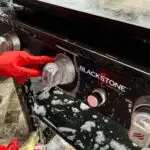Welcome to our comprehensive step-by-step guide on solving all of your Blackstone Griddle cleaning and seasoning problems.
Whether you’re restoring an old rusted griddle or are looking for tips on removing burnt-on oil and food debris, we’ve created this post to demonstrate the different methods folks use to restore their griddle and showcase which of these methods work best.
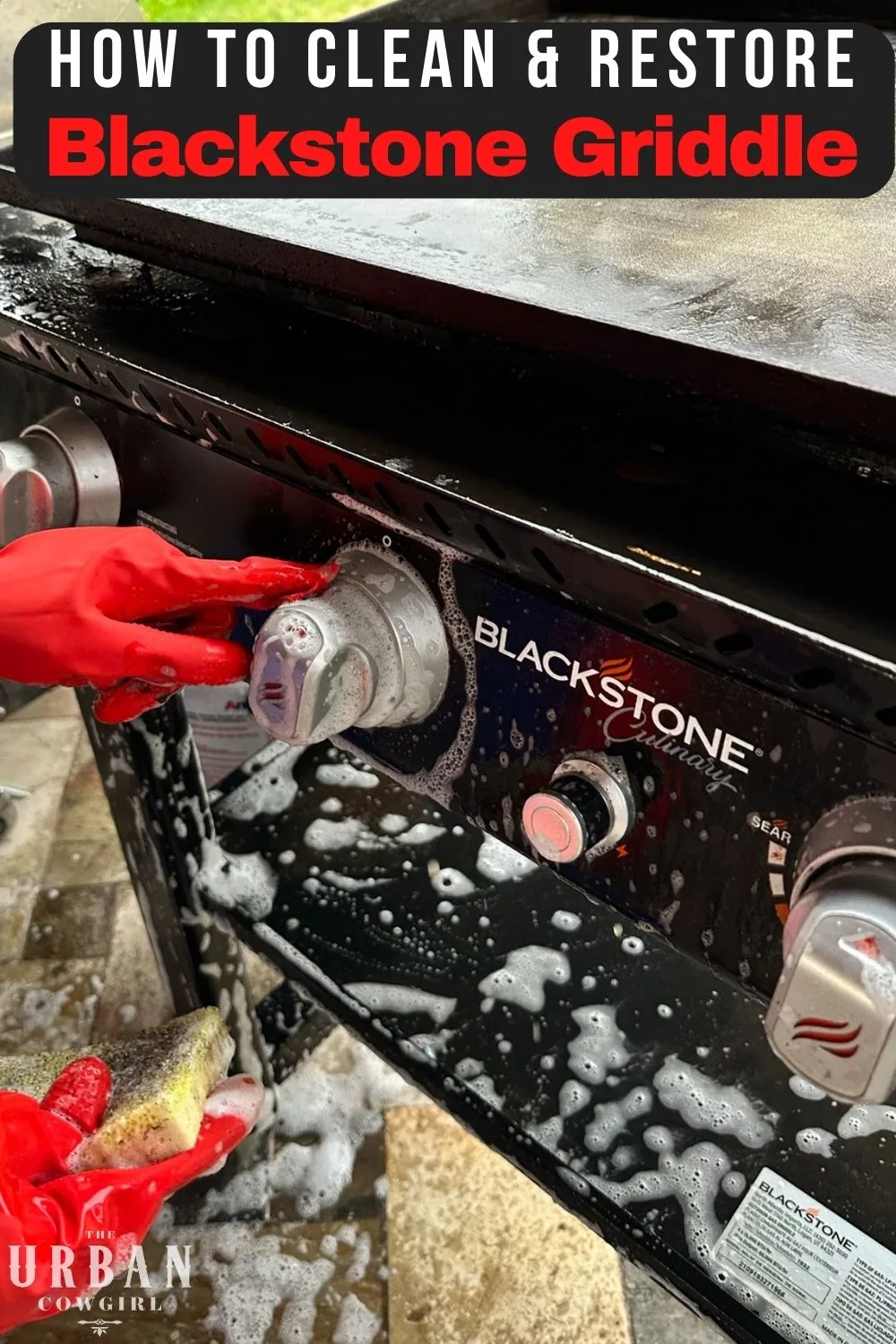
From taking a sander to burnt-on grease and grim, to vinegar and brillo pads for dissolving rust and sludge, this post will demonstrate how to clean every inch of your griddle and restore it to a shiny finish.
The Fine Print: I’m Chef Sarah, a 15-year veteran chef of professional kitchens where I am no stranger to industrial griddles, cast iron, and steel. This post was written with the help of a chemist who helped me understand the best practices for working with these materials. I do not work for Blackstone and have written this post as a chronicle of how I, and others, have managed to keep our griddles looking beautiful. Using any of these methods is done at your own risk.
Table of Contents
- What Is The Blackstone Griddle Made Out Of?
- Cleaning a Blackstone Griddle Cooking Surface (After Cooking)
- Tools you’ll need for Cleaning a Blackstone Griddle
- Can You Use Soap On The Blackstone Griddle?
- Restoring a Blackstone Griddle (Cleaning Rust and Severe Layers of Burnt Oil & Grime)
- Cleaning Tools For Extreme Griddle Restoration and Reseasoning
- How To Get Rust Off A Blackstone Griddle
- How To Remove Layers Of Burnt On Oil From Your Griddle
- Reaseasoning the Blackstone Griddle After Restoration and Deep Cleaning
- To Reseason the Grill Surface:
What Is The Blackstone Griddle Made Out Of?
Before we can determine the right method to clean an object, we first need to know what the object is made out of. This prevents damaging the material with abrasive substances or chemicals that would deteriorate the integrity of the item.
The Griddle
The griddle surface is made out of steel, not cast iron as many believe.
However, these two metals are extremely similar in the purposes of maintenance and cleaning so you will find all cast-iron care knowledge is useful.
The griddle is solid steel. There isn’t a manufactured non-stick surface you need to be afraid of scratching.
In fact, when restoring cast iron or steel you can sand down the surface, reseason with oil, and start all over again. This isn’t always necessary, but it’s always possible and it won’t damage the metal to thoroughly clean and reseason it.
We know that Steel is (Iron + Carbon)
And we know that (Iron + Water + Oxygen) = Rust
Using this knowledge we can reason two things.
1) We can use water to clean our griddle (it’s a misconception that no water may ever be applied to cast iron or steel), but we need to dry it quickly and reason it with oil regularly.
2) Those who live in humid environments or leave their griddle on the porch will deal with rust on a regular basis.
(Links are affiliate links to products we think are helpful and we may receive a small commission, at no cost to you, if purchased.)
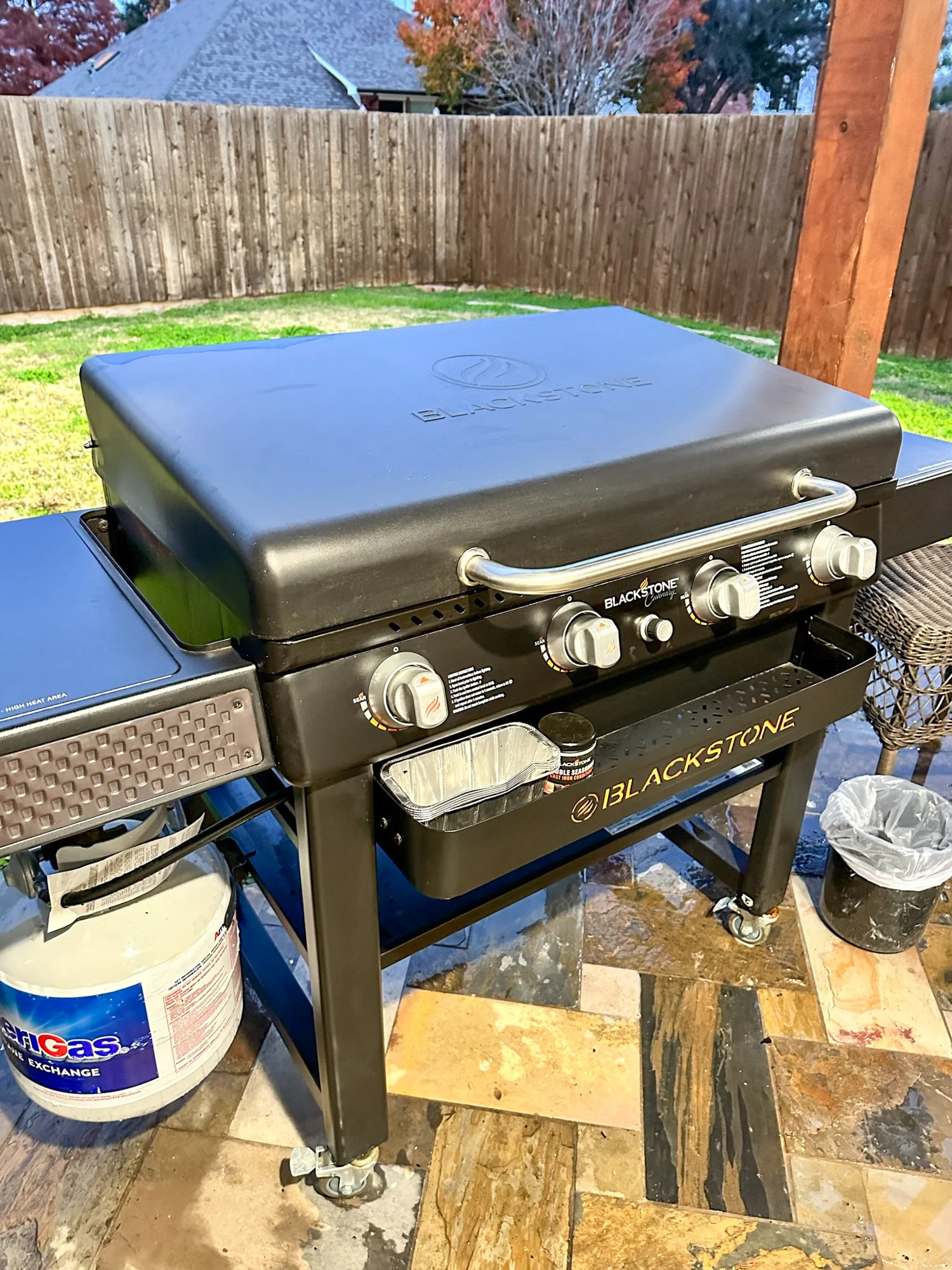
The Base, Knobs, Stand, and Debris Chamber
Blackstone doesn’t tell us what the stand is made out of but we can see that it is a metal and that it does not tend to rust easily. We regularly use hot soapy water and a scrub daddy to clean the stand and this seems to work great.
The knobs are the most problematic piece on the appliance because they’re made of plastic. We pop them off by squeezing gently and soak them in soapy water. Though this entire area is prone to drips of grease you won’t be able to clean the knobs with a magic eraser or scrub daddy without severely scratching the paint.
You can clean these knobs as best you can with a soft sponge and dish soap, or give them a scrub with a proper scrub sponge and deal with the scratched paint. (We hope they will stop using painted plastic knobs in the future.)
The base that the griddle is perched on is prone to rust. It’s been discussed in many online forums that the paint used here bubbles up and deteriorates quickly.
I have found that cleaning this area is nearly impossible and the only way to truly restore it is to scrub this area well and repaint it regularly with high heat barbecue black spray paint.
The debris chamber is a little removable cup fastened to the back of the griddle on a hook. This collects any scrapings, grease, and sauce runoff.
It’s easiest to line this debris cup with a foil tin (they are sold in bulk on Amazon) but another hack is to line it with several layers of aluminum foil and remove and replace this regularly. When the debris cup gets really gross, I wash it in the kitchen sink and send it through the dishwasher.
Cleaning a Blackstone Griddle Cooking Surface (After Cooking)
- Wipe with a folded wet rag between courses
- Let the griddle cool down to prevent burns (it can be warm, not hot)
- Scrape well using a griddle scraper and wipe all residue into the debris chamber
- Use hot water and scouring pads if necessary on stubborn debri (see below)
- Wipe with an oil-soaked paper towel to “reseal” the seasoning
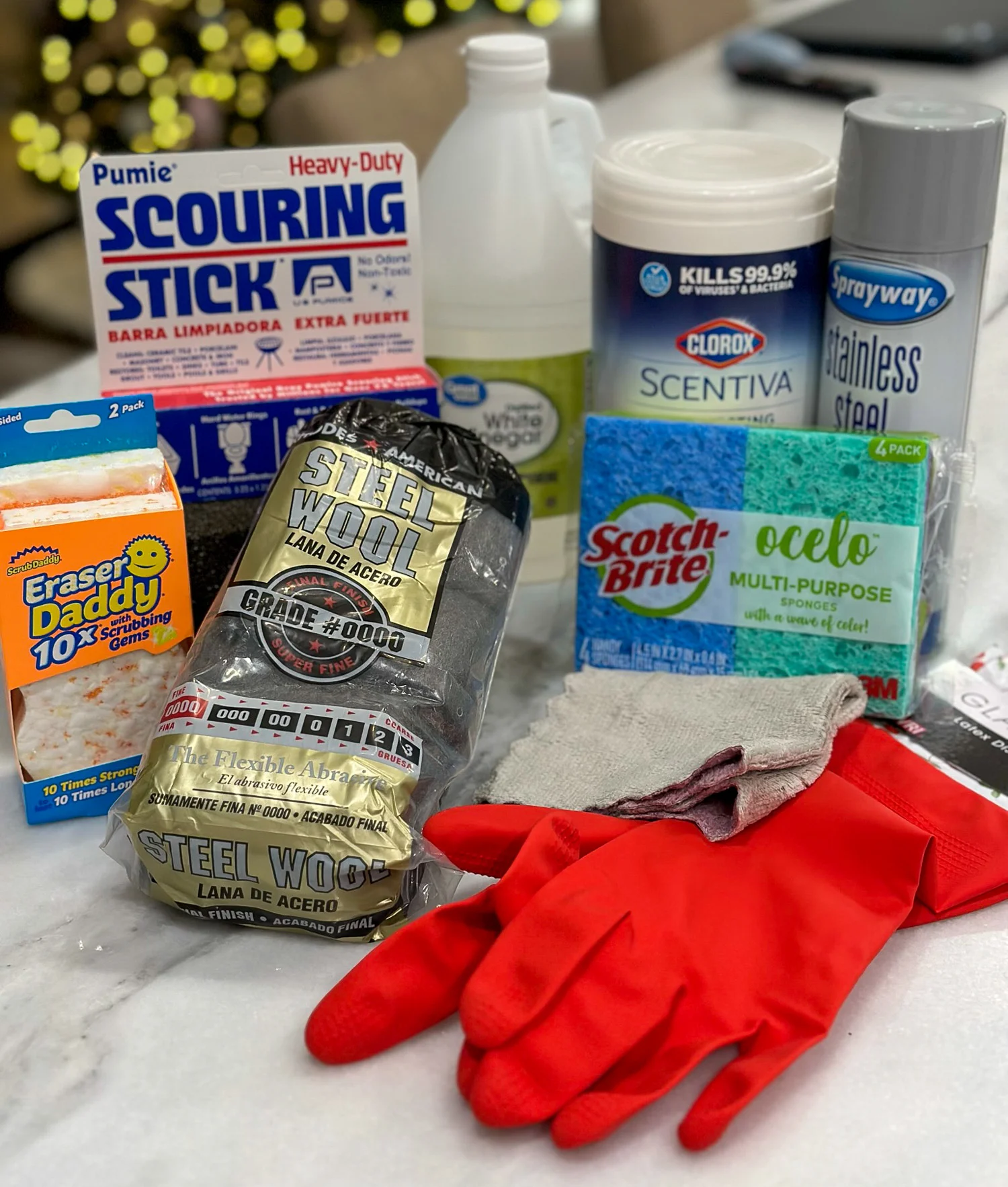
Tools you’ll need for Cleaning a Blackstone Griddle
A Wet Folded Rag
Paper Towel Soaked with Oil or Blackstone Griddle Seasoning
I believe you should always have a set of kitchen rags dedicated to your Blackstone Griddle for wiping it between courses. You see this habit often on my Youtube Channel’s Blackstone Recipe Series.
This is an important habit so that when it’s time to clean the flat top grill after a big meal, it’s an easy process that doesn’t involve burned on sticky sauces and layers of food residue.
After Cooking A Meal
After cooking, it’s important that you let the griddle cool down as the surface of the griddle is too hot to clean. Scrape it with a metal griddle scraper and then scrub it with an orange griddle pad while the griddle is warm, but not hot.
If the water is poured on a very hot skillet it will immediately turn to steam and can burn your hands.
If you’re still not able to remove debri with the scouring pad and hot water you may need to use a pumice grill stone to scrub the area— but this is rare and if you find yourself reaching for these often you may be cooking at too hot of temperatures.
After all food particles are cleaned from the griddle top, wipe with a rag moistened with warm water, dry well, and coat the entire surface with a thin layer of oil, rubbed on with a paper towel.
Close the lid if you have one. (I highly recommend the lids and can’t imagine not having one to protect it between uses.)
Can You Use Soap On The Blackstone Griddle?
Yes, but you don’t want to.
The question is more about understanding the methods for cleaning cast iron and steel, versus the risks of adding substances that will change the flavor of your food.
It seems that by now people understand that you can use water on cast iron and steel, quickly clean up the mess, and then dry and re-oil it with zero issues.
You can use soap on a new Blackstone griddle before seasoning it, or anytime you are in a position to thoroughly restore a damaged griddle and plan on reseasoning it.
Soap presents a problem for a seasoned griddle’s surface because although it does dissolve fat and oil (allowing these molecules to be swept away with water) it seems to bind to this protective coating and can leave food with the aroma and flavor of dish soap.
Even if you find fragrance-free soap you can taste it in food and it’s very hard to get the taste of soap off of the griddle.
The methods here are a workaround. They too remove food, grease, and other debris without reaching for dish soap.
If you want to use a tiny bit of soap for a particularly messy cook, I recommend diluting a little bit of soap in water and working with the warm soapy water quickly, to clean up the mess and get the soap off the griddle’s surface.
This works best with a cool griddle, as a hot griddle will boil and evaporate the water in your soapy water mixture, leaving the soap residue on the surface of the griddle.
Rinse your griddle well several times and familiarize yourself with the alternative ways to clean a griddle without soap, later in this guide.
Restoring a Blackstone Griddle (Cleaning Rust and Severe Layers of Burnt Oil & Grime)
I love these things because you can take a beat-up, mistreated, rusty griddle and restore it to looking like a new griddle with a little love and elbow grease.
For extreme cases let’s discuss the options and tools you can use.
Cleaning Tools For Extreme Griddle Restoration and Reseasoning
- White Vinegar In A Spray Bottle
- Steel Wool (fine grade)
- Large Grill Stone
- Griddle Scouring Pads (these are orange)
- Electric Sander fitted with 60 Grit Sandpaper
- A Water Hose With Fine Point Pressure Sprayer
- Dry Rags
- Blackstone Griddle Seasoning or High Smoke Point Oil (Avocado Oil, Canola Oil, etc.)
How To Get Rust Off A Blackstone Griddle
For just a bit of light rusting a Blackstone scouring pad or grill stone should do the trick– but for more intense deeper levels of rust, experts like Lodge Cast Iron, recommend white vinegar.
Of course, the vinegar will dissolve the Blackstone Griddle rust but afterward will go after the griddle itself, so the trick is to leave the vinegar on only until the rust begins flaking off and promptly spray the vinegar off your griddle with warm water.
Here are the simple steps we use to remove rust…
- Spritz the rusted areas of the griddle with white vinegar (we’ve also heard you can use lemon juice) and wait 5 minutes.
- Begin scrubbing with fine-grade steel wool (available at hardware stores) or a pumice stone, working the rust off.
- Apply more vinegar if needed to work the rust off the Blackstone Grill.
- Scrub the surface with hot water and a griddle scouring pad until you’re satisfied with the results.
- Wipe off all debris using warm water if necessary.
- Heat the griddle and reseason with a fresh layer of griddle seasoning or cooking oil.
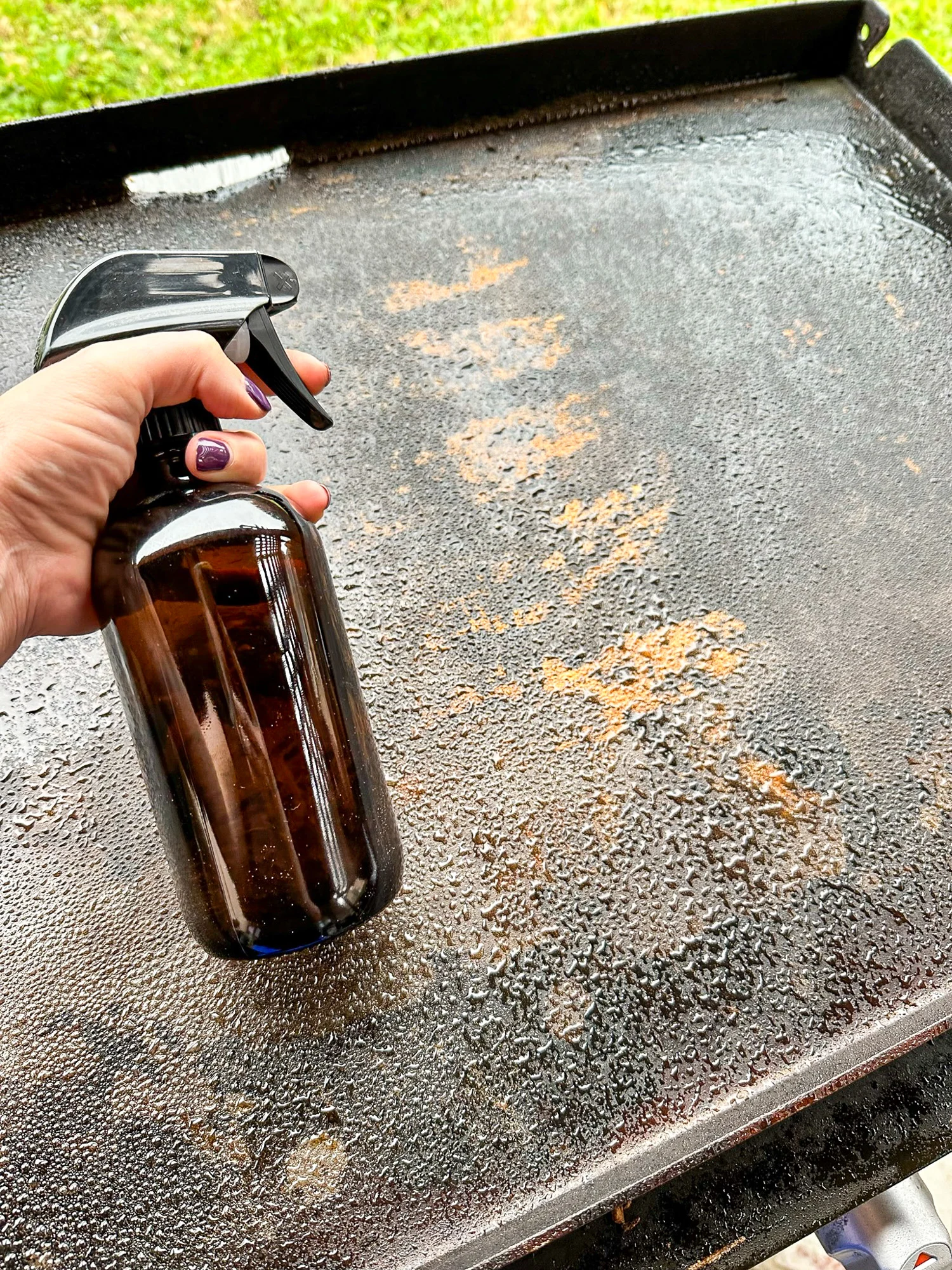
The good news is a rusty Blackstone griddle can be avoided in the future by purchasing a lid for your griddle or storing it in a dry place.
Reseasoning with the brand name Blackstone Griddle Seasoning has been a game-changer here in the high humidity region of Texas.
Their blend contains beeswax and a combination of several oils with different protective properties, so although I don’t see the need to recommend every product Blackstone pushes, I really like their brand name griddle seasoning.
How To Remove Layers Of Burnt On Oil From Your Griddle
Sandpaper Method
There seems to be confusion about the surface of a well seasoned griddle, and the mounds of black burnt-on oil that look like the griddle’s surface but flake into food.
If you continuously see black bits in your food, that is not seasoning… you have burnt food and oil on the surface that needs to be scraped off and depending on the severity of this burnt layer and how long you want to scrub, you may need to get your household sander out.
With a standard sander, we tried a few different grit options of sandpaper and 60 grit worked best at removing burnt-on black debri without rapidly creating a hole in the sandpaper.
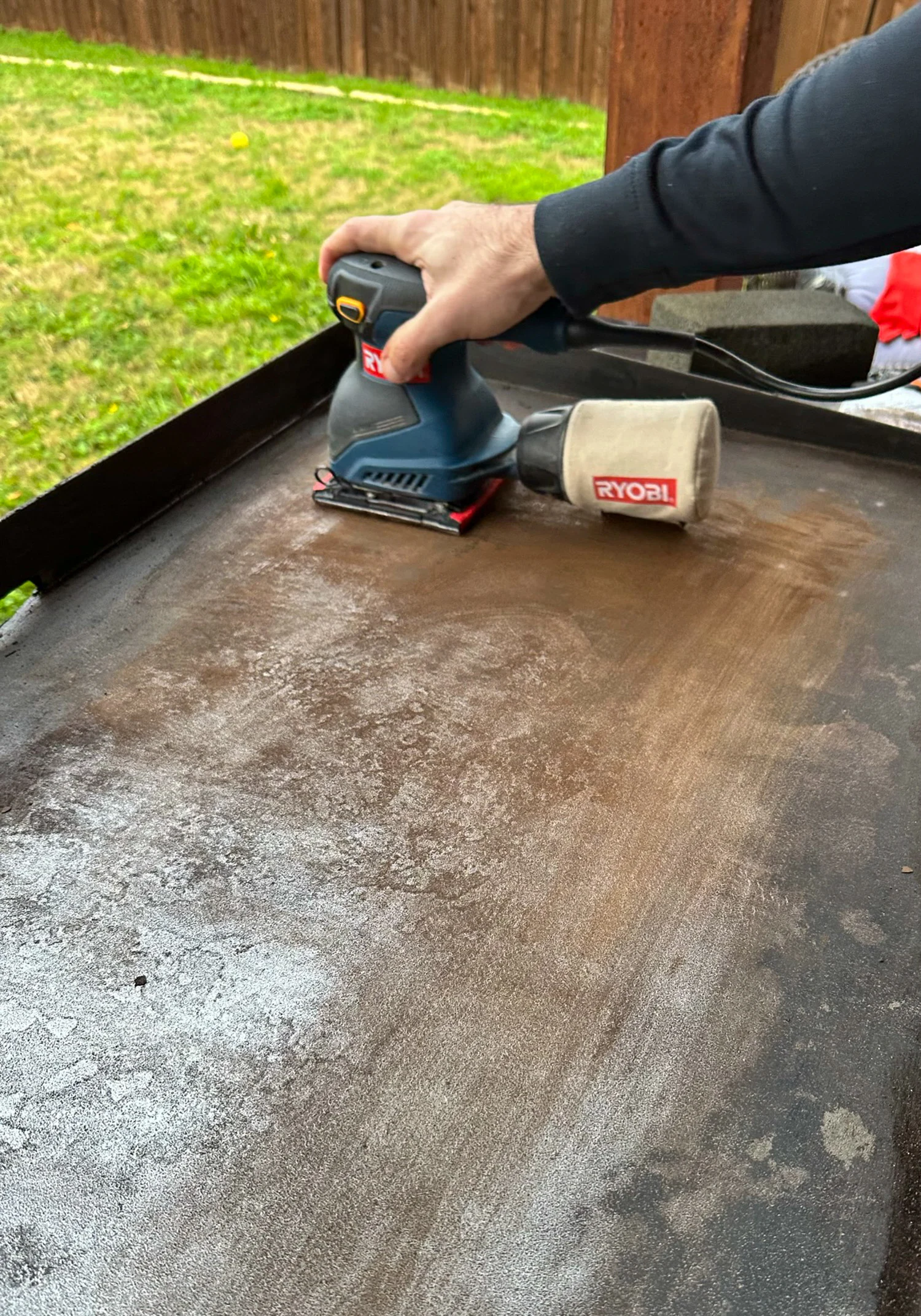
If you already have sandpaper in your garage you can probably get away with using whatever you’ve got, but we did find 60 grit was the best way to create enough friction to remove the burnt on oil.
After sanding the black off you’ll need to rinse with water and preseason the entire griddle, so just be aware this is not something you want to be doing all the time.
Sanding is the apocalypse scenario for mistreated griddles (or those of us learning proper griddle maintenance that first year).
Large Grill Stone Method
Here is a secret I’ve learned about grill stones!
You can buy massive-sized grill stones on Amazon that are cheaper and 6 times the size of what Blackstone is selling. These grill stones are also sold at home improvement stores labeled as a pumice stone. (All of these are the same product produced in different sizes).
These work incredibly well at getting a burnt on layer of oil or sauce off right after cooking. They work a bit like sandpaper grinding down layers of food and grease that have turned into a black impenetrable layer.
I would recommend picking up a few and keeping them on hand for regular griddle maintenance.
To use one you’ll just use the grill stone and a bit of water in a scrubbing motion on the areas of concern.
With lighter layers of grim the grill stone works great, but it can scrape away your seasoning layer, so always recoat with oil after a good cleaning with a grill stone.
Griddle Scouring Pads
Griddle Scouring Pads from Blackstone are their signature orange color and work great with a bit of water to scrape griddles right after cooking a meal. Many off-brand options exist and are just as good as Blackstone’s high priced versions.
These should be your regular workhorse for cleaning a griddle after cooking, before reaching for more serious options. Keep a few of them under your griddle at all times for routine cleaning.
Water Hose With Fine Point Pressure Sprayer
When deep cleaning my Blackstone Griddle, I use my water hose and a simple fine-point pressure sprayer from a home improvement store to blast all the black dust off that I am surely making with things like my sander or grill stone.
This is not a pressure washer. This is just a simple attachment from the garden center. Spray the whole thing clean and watch the black dust go flying, then dry the griddle with a microfiber towel all over.
Reaseasoning the Blackstone Griddle After Restoration and Deep Cleaning
You probably seasoned your griddle the first time you heated it up (unless you inherited one from a friend) but it’s always good to reseason after a thorough cleaning.
The best oil for reasoning is (in my honest opinion) the Blackstone Griddle Seasoning, which contains some high smoke point oils combined with beeswax. I love this product over any other add-ons they sell and it’s the perfect product to create that protective layer we need for our griddles.
If you can’t find it you can always use any high smoke-point oil such as safflower oil, avocado oil, coconut oil, and sunflower oil.
Do not use olive oil or vegetable oil as it doesn’t have a high enough smoke point to season the grill’s surface.
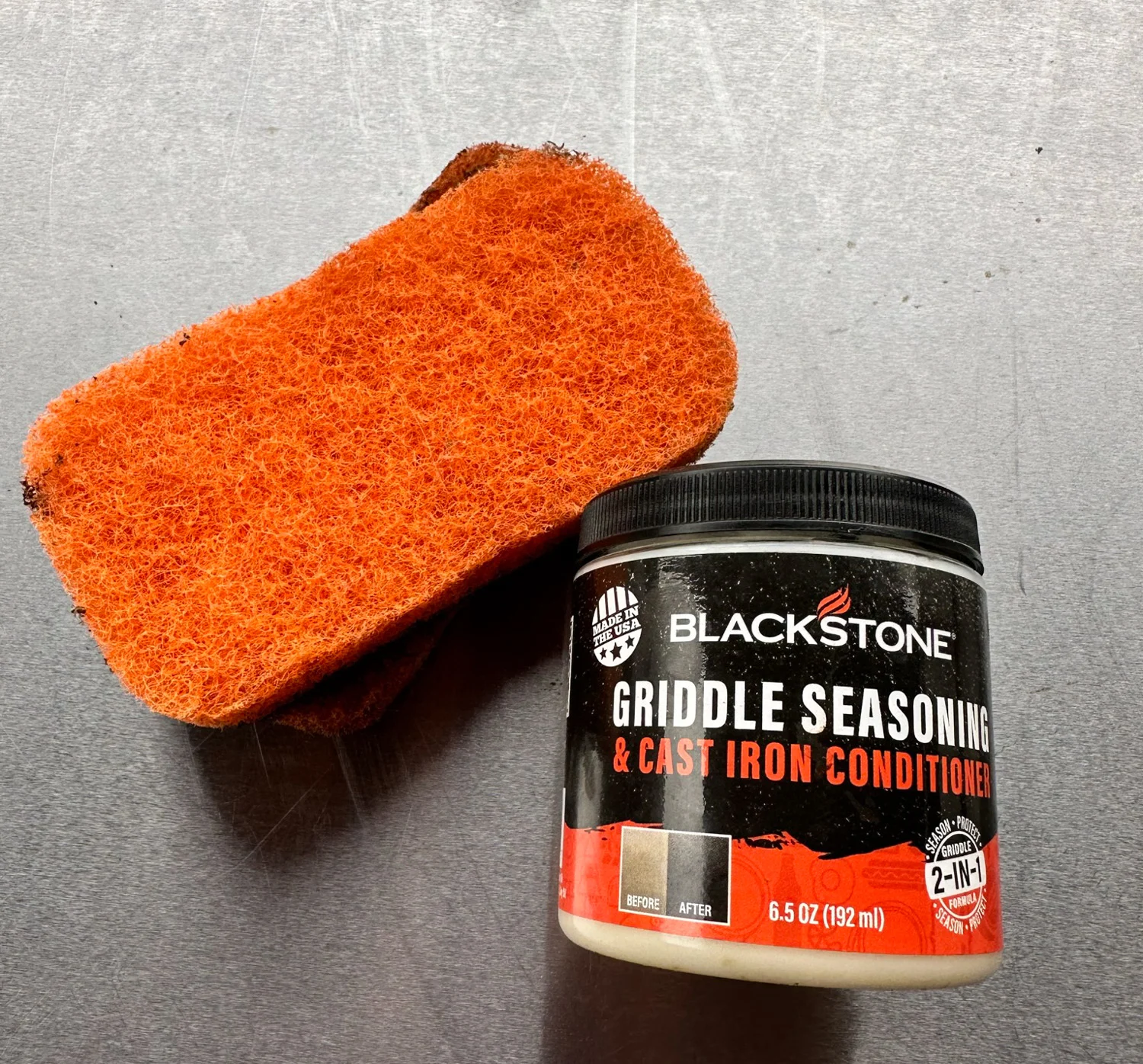
To Reseason the Grill Surface:
- Make sure the surface is sparkling clean through any of the cleaning processes we described above. Wipe with a damp rag to remove dust.
- Coat it with a thin layer of oil or griddle seasoning brushed on with a paper towel. Then turn the griddle up to high heat. Excess oil will burn so just make sure it’s shiny and not laden with oil.
- Heat for 15 minutes at high heat.
- The final step is to repeat 2-3 times until the surface becomes dark.
Now you’ll simply add to this initial seasoning process every time you cook on your griddle and use a few tablespoons of oil in your recipe.
Correct and proper griddle cooking technique comes with time and experience. Soon you won’t need to take any drastic cleaning measures, as you get to know your griddle better, and learn how much heat and oil to use when making delicious food!
With regular cleaning stuck-on food is avoidable and these cleaning tips will help keep your griddle plate in tip-top shape.
Have questions? Need help? Have an addition or a suggestion to a recipe? Drop me a comment below!
If you make this recipe, I would LOVE to see it!
Tag me on Instagram @UrbanCowgirl and use #UrbanCowgirl to be featured. 🙂
Follow us on Social Media using the links below!!

